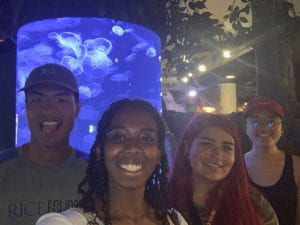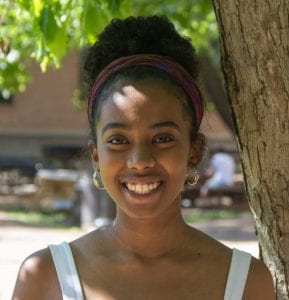Finding My Engineering SEED
Booted Up
The first week back at the OEDK feels like no other. The OEDK seems much calmer and does not have nearly as much traffic as it does during the academic year. Nonetheless, the SEED Teaching Assistants, Adulfo Amador and Grant Anderson, and Dr. Hunter keep our pace running at high gear all through bootcamp week. As first week interns, we were fully immersed into the engineering design process with the introduction of our first mini-project, designing an enrichment feeder for Luna the Red River Hog at the Houston Zoo. Throughout the week, we visited the Houston Zoo a couple times in order to firstly bond with the fellow SEED interns and secondly interview our client, Kim the Zookeeper.
This was the first time I have visited the Houston Zoo, which seems absurd to me since it is barely a 20 minute walk from Baker College. I was utterly mesmerized by the zoo’s beauty and mere size. The most fascinating animals I saw at the zoo were the jellyfish! During the scavenger hunt, which acted as our first group bonding event, one of the hints involved the Moon Jelly Fish. The hint was phrased somewhat like “Like other species of jellyfish, these animals do not have eyes, a brain, or a heart. They are also 95% water.” I did not know this fact about jelly fish prior to this visit and found it extremely intriguing.

The Winning Scavenger Hunt Team Left to right: Dylan Rivera, Magdah Omer, Alexus Arizola, and Audrey Yao
The second time we visited the Houston Zoo, we conducted an approximately one hour long interview with Kim the Zookeeper in which she clarified the problem statement and explained her expectations for the enrichment feeder. We were shown around the stall where Luna spends her most her nights, where we took some measurements and interacted with some existing puzzle feeders.
Can I Take Your Manufactured Devices Apart?
Another interesting and educational activity we indulged in involved deconstructing manufactured devices (an old TV and a Wii FitBoard) in groups of three or so. Corbin, Audrey, and I started off by dissecting the Wii FitBoard to reveal its inner frame and four load cells, which were found at each corner of the board. Now, I definitely did not know what a load cell was prior to taking apart the FitBoard. When my group and I found the sensors embedded in the four corners of the board, we first assumed they were pressure sensors. However, upon consulting with Grant, Adulfo, and Dr. Hunter, we learned that they are load cells and are a type of pressure sensor called a strain-gauge load cell. According to Omega.com, “strain gauge force sensors convert the load acting on them into electrical signals. The gauges themselves are bonded onto a beam or structural member that deforms when weight is applied. In most cases, four strain gauges are used to obtain maximum sensitivity and temperature compensation.” I found the information and experience that I learned from this activity especially valuable, and look forward to what SEED has to offer moving forward.

